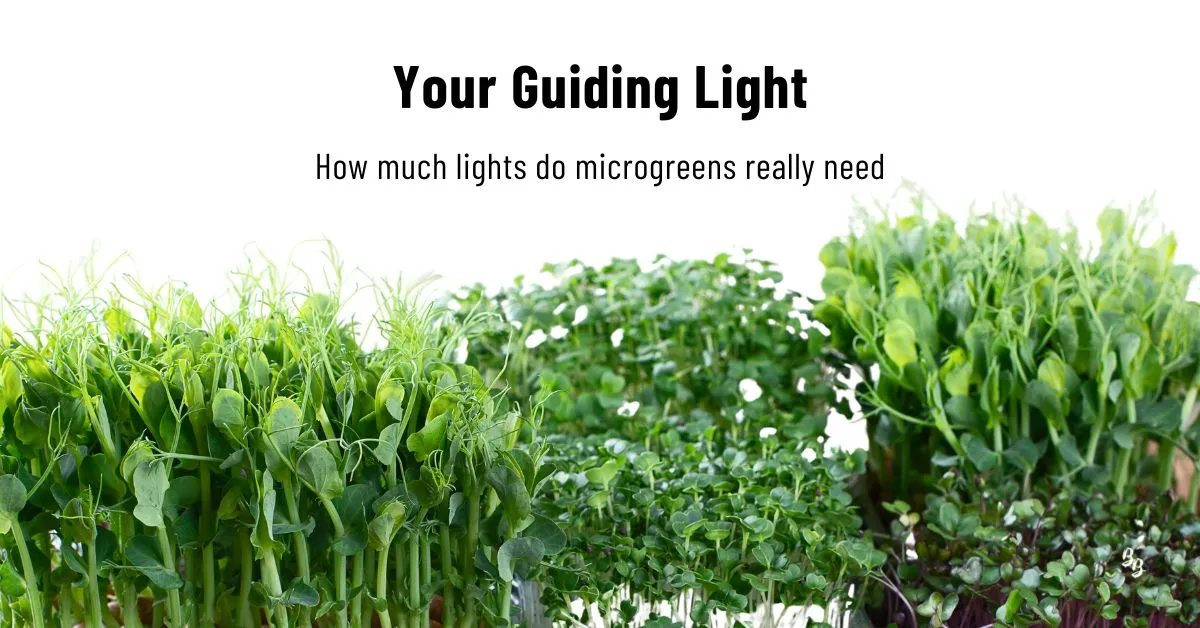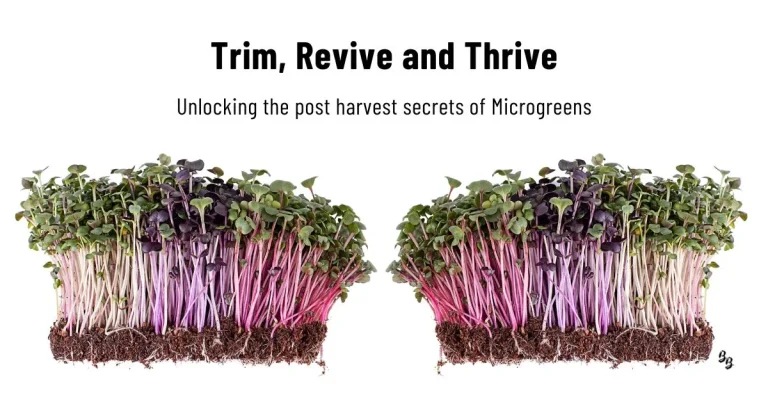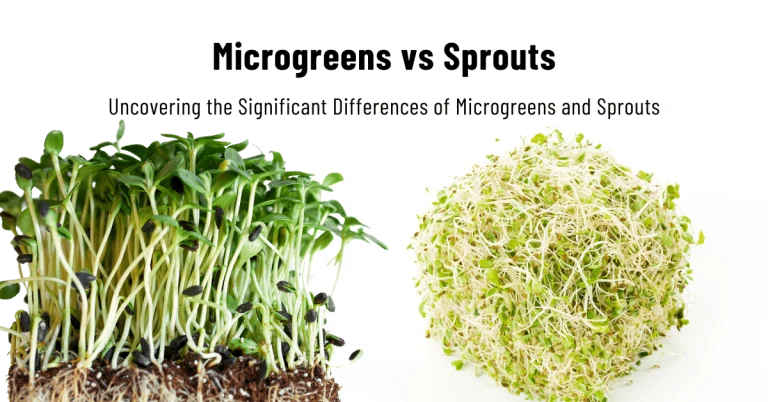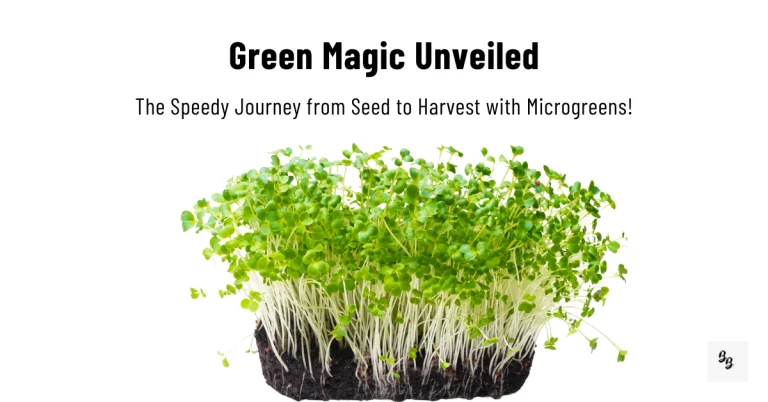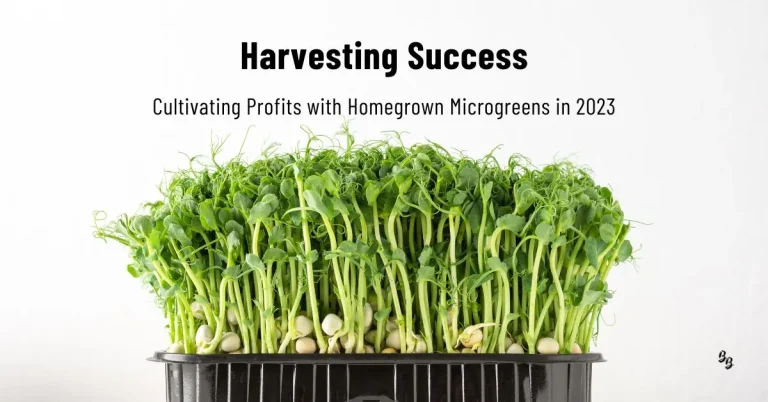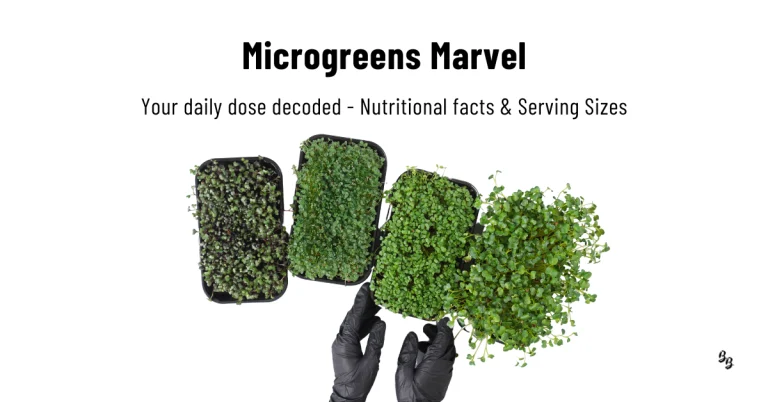How Much Light Microgreens Need to grow effectively?
How much light do microgreens need to grow? Are fluorescent lights a necessity for growing microgreens? Do you need supplemental lights? Can natural light alone provide sufficient conditions for these tiny greens to flourish?
These questions often cross the minds of aspiring microgreen growers looking to cultivate these nutritious wonders right in the comfort of their homes.
In this blog, we’ll delve into the fascinating world of microgreen cultivation to shed light on whether fluorescent lights are essential or if natural light can indeed be enough to nurture these miniature powerhouses.
So, let’s embark on a journey through the realm of microgreens and discover the best ways to grow them, with or without artificial lighting.
Do microgreens really need lights to grow, if so, how much light?
Microgreens do not necessarily require artificial lights to grow; they can indeed grow in natural or indirect light conditions.
Microgreens are edible plants, with true leaves that are young and tender. They get harvested at an early stage of growth, usually within 1-3 weeks after germination.
During this short growth period, they can benefit from adequate light to ensure healthy development and vibrant colors.
Natural light from windows or outdoor locations can be sufficient for growing microgreens, especially if you choose varieties that thrive in lower light conditions.
South-facing windows generally receive the most lit, while east or west-facing windows can also work well.
Yes, south-facing windows are generally an excellent choice for growing microgreens in South Africa.
South-facing windows receive the most direct sunlight throughout the day in the southern hemisphere, including South Africa.
This orientation allows for optimal light exposure, which is essential for the healthy growth of microgreens.
Melanie du Plessis
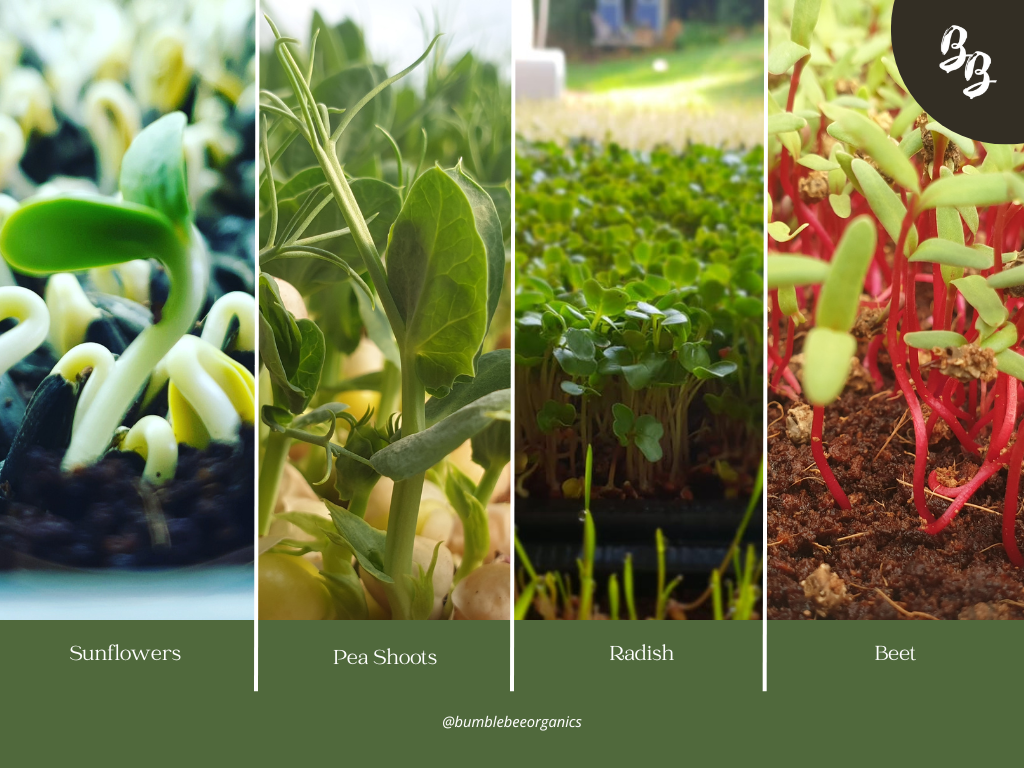
However, keep in mind that the intensity and duration of natural light can vary based on your geographical location, seasonal changes, and weather conditions.
So, it’s essential to choose the right microgreen varieties and provide them with enough light for successful growth.
If you have limited access to natural light or want to grow microgreens year-round regardless of weather conditions, you can still use artificial grow lights.
Full-spectrum LED grow lights are a popular and energy-efficient option. Closely mimicking natural sunlight, promoting optimal growth, and allowing you to grow microgreens indoors without relying solely on sunlight.
How much light does microgreens need to grow?
Microgreens require an adequate amount of light to grow healthily and develop their full potential. The amount of light they need can vary depending on the specific variety, growth stage, and environmental conditions.
Here’s a general guideline for the amount of light microgreens need:
Natural Light:
Microgreens typically require around 4 to 6 hours of direct sunlight per day for optimal growth.
If you’re growing microgreens indoors, place them near a south-facing window, as it usually provides the most intense sunlight. East and west-facing windows can also work, but they might offer slightly less light.
If your indoor growing space has limited natural light, consider using supplemental artificial grow lights to ensure your microgreens receive enough light.
Artificial Light:
When using artificial grow lights, microgreens generally need around 12 to 16 hours of light per day. Full-spectrum LED grow lights are the best choice, as they provide the necessary wavelengths for optimal photosynthesis and growth.
The grow lights should be positioned at an appropriate distance from the microgreens to prevent heat stress or burning while providing sufficient light intensity.
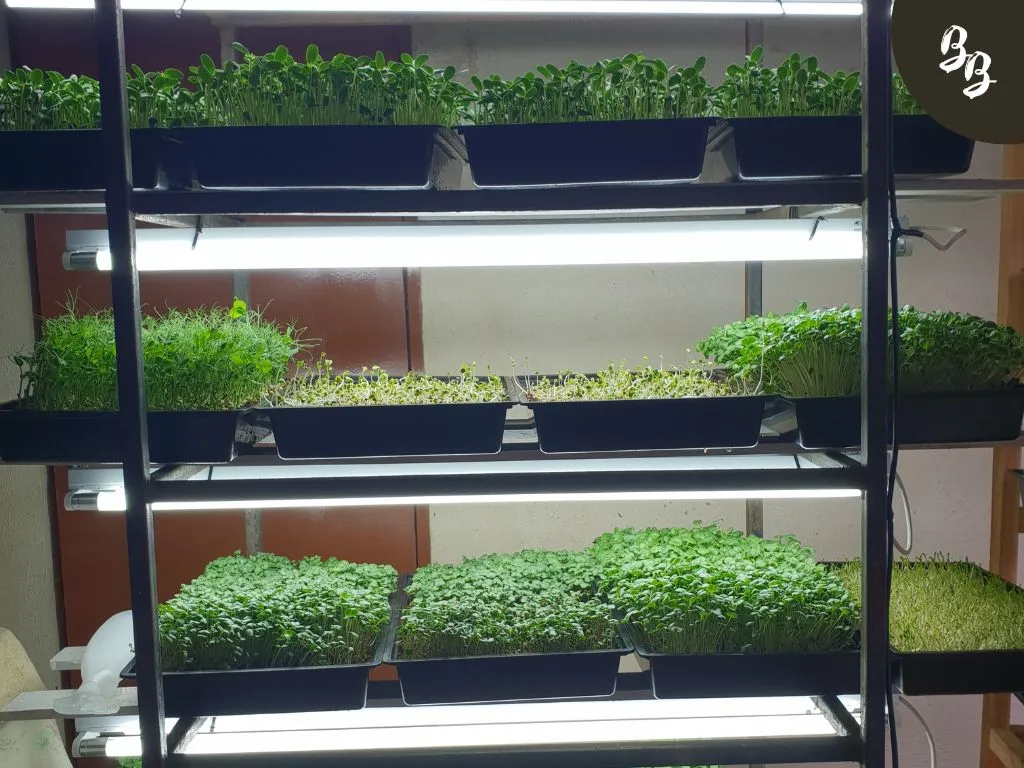
Keep in mind that different microgreen varieties may have specific light requirements. Some varieties may tolerate lower light conditions better than others.
Monitoring the growth and appearance of your microgreens is essential to ensure they are getting the right amount of light. If they appear leggy, pale, or elongated, it may indicate insufficient light, and you should adjust their light exposure accordingly.
Ultimately, providing the right amount of light is crucial for robust and flavorful microgreens. Adequate light ensures they develop vibrant colors, strong stems, and a rich concentration of nutrients, making them a valuable addition to your meals..
How does light affect the plant growth of microgreens?
Light plays a crucial role in the plant growth of microgreens, influencing various aspects of their development.
Here are some ways in which light affects the growth of microgreens:
Photosynthesis:
Light is essential for the process of photosynthesis, where plants convert light energy into chemical energy to produce glucose (sugar) and oxygen.
This energy is used to fuel the growth and development of microgreens. The more light microgreens receive, the more efficiently they can carry out photosynthesis and produce energy for growth.
Leaf Expansion:
Adequate light promotes the development of healthy, green leaves in microgreens. Insufficient light can lead to pale, elongated, or leggy growth, as the plants may stretch to seek more light.
On the other hand, with the right amount of light, microgreens develop compact and lush foliage.
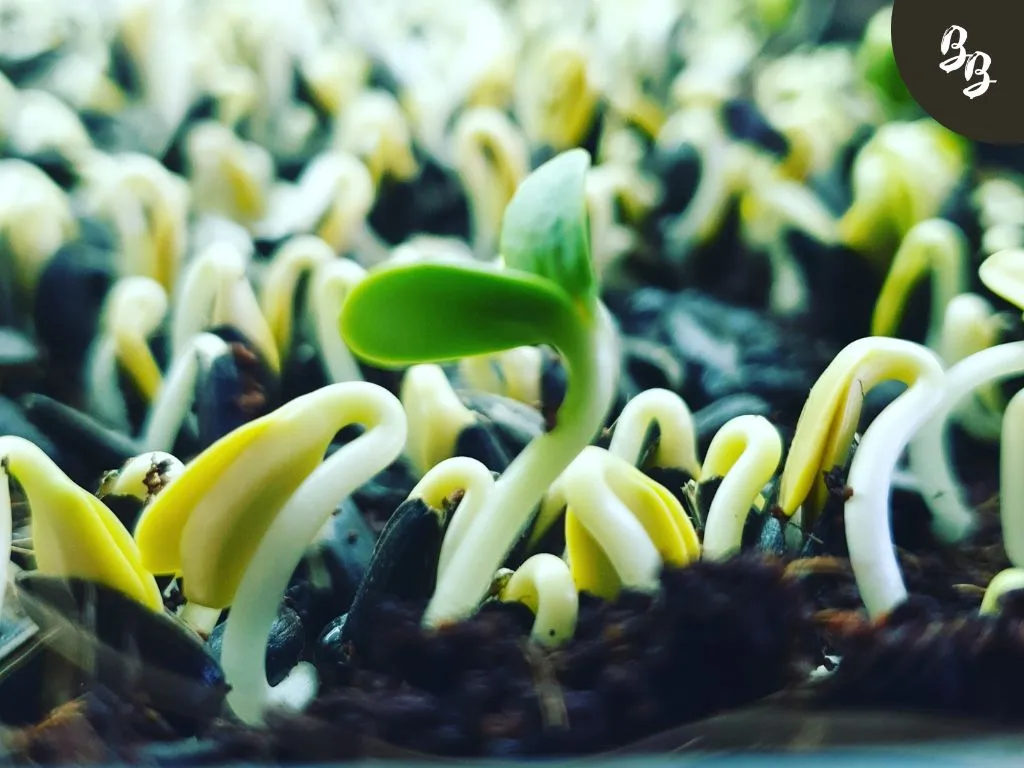
Chlorophyll Production:
Chlorophyll is the pigment responsible for capturing light energy during photosynthesis. Sufficient light exposure results in higher chlorophyll production, giving microgreens their characteristic green color.
Nutrient Synthesis:
Light influences the synthesis of essential nutrients in microgreens. For instance, certain vitamins and antioxidants increase with exposure to light, making well-lit microgreens more nutritious.
Stem Strength:
Microgreens grown in adequate light develop strong and sturdy stems. This strength is crucial for supporting the leaves and providing stability to the plants.
Flavor and Aroma:
Light can impact the flavor and aroma of microgreens. Proper light exposure can enhance their taste and aroma, making them more flavorful and enjoyable.

Growth Rate:
The rate of growth in microgreens is influenced by light intensity and duration. More light generally leads to faster growth, resulting in quicker harvests.
It’s essential to strike a balance with light exposure.
Too little light can lead to weak, spindly plants with poor nutritional value, while too much light might cause heat stress or scorching.
Overall, providing the right amount of light is crucial for the successful growth of microgreens, ensuring they develop into vibrant, healthy, and nutrient-packed greens ready to be harvested and enjoyed in a variety of culinary delights.
The best grow lights that microgreens need to grow
The best lights for growing microgreens are usually full-spectrum LED grow lights.
These young, tender greens require sufficient light to grow quickly and develop their vibrant colors and flavors.
Here are some reasons why LED grow lights are ideal for microgreens:
Energy-efficient:
LED grow lights consume less electricity compared to traditional lighting options, making them more cost-effective in the long run.
Full-spectrum light:
LEDs can provide a full spectrum of light that closely mimics natural sunlight, which is crucial for the healthy growth of microgreens.
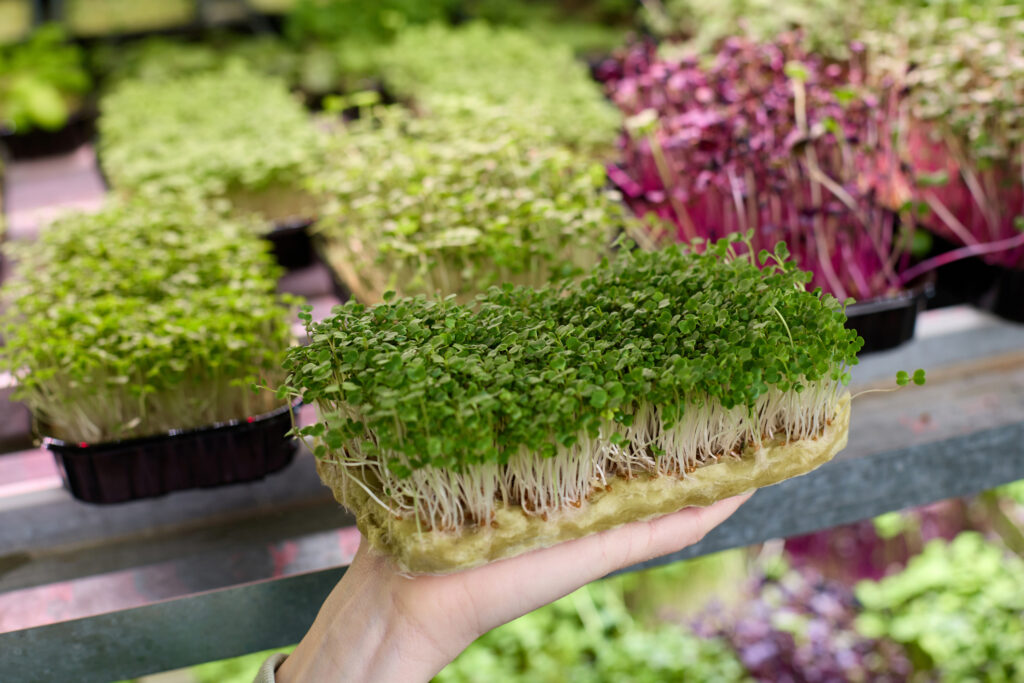
Cool-running:
LEDs produce less heat than other types of lights like high-intensity discharge (HID) bulbs. This helps maintain a suitable temperature for microgreens without risking heat stress.
Customizable spectrum:
Some LED grow lights allow you to adjust the light spectrum, which can be beneficial for different stages of microgreen growth.
Compact design:
LED grow lights are often sleek and slim, making them suitable for small growing spaces and vertical setups.
Long lifespan:
High-quality LED grow lights can last for thousands of hours, providing consistent performance throughout the growing season.
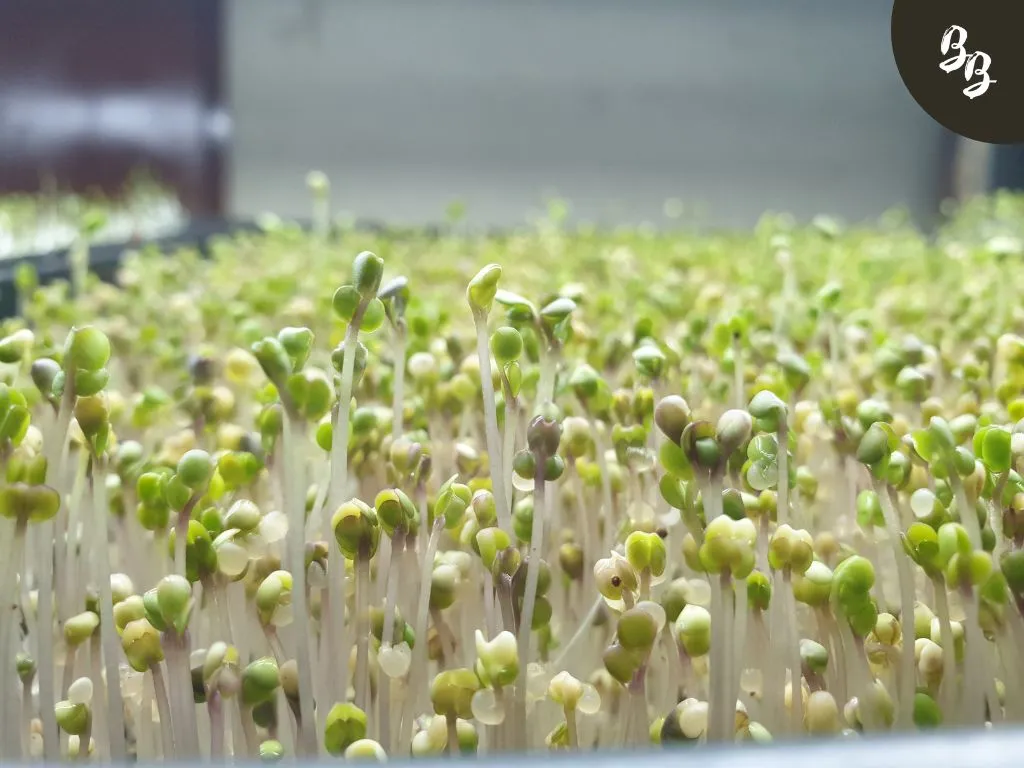
Blue and Red growing lights:
Full-spectrum LED lights for growing microgreens typically include a balanced mix of blue, red, and other wavelengths to mimic natural sunlight. The combination of blue and red light is essential for promoting healthy photosynthesis and optimal growth in plants.
Blue Lights:
Blue light (wavelengths around 400-500 nm) is crucial for the vegetative growth of plants. It is essential for promoting strong, compact foliage, as well as for stimulating chlorophyll production, which is necessary for photosynthesis.
Red Lights:
Red light (wavelengths around 600-700 nm) is vital for flowering and fruiting in plants. For microgreens, which are typically harvested at an early stage of growth before flowering, red light still plays an important role in promoting healthy growth and development.
By using full-spectrum LED lights that emit a combination of blue and red light (along with other wavelengths), you can ensure that your microgreens receive the optimal light conditions they need to flourish.
These lights are designed to closely mimic natural sunlight and provide a suitable environment for the healthy growth of microgreens indoors, especially when natural light is limited or not available.
When choosing LED grow lights for microgreens, consider the following factors
Wattage:
The wattage of the light will determine how much area it can cover. For microgreens, lights in the range of 20-40 watts per square foot are generally sufficient.
Light spectrum:
Look for full-spectrum lights with a balanced mix of blue, red, and white light to support the different growth stages of microgreens.
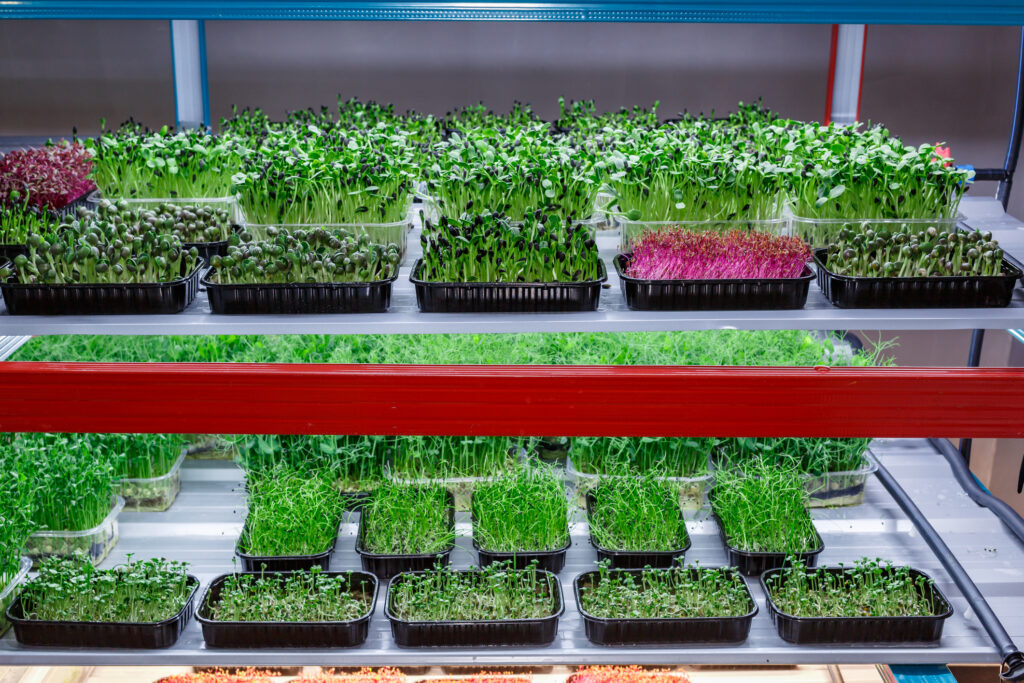
Coverage area:
Consider the size of your growing area and choose lights that can adequately cover all your trays or containers.
Adjustable height:
Lights with adjustable height settings are useful as they allow you to maintain the right distance between the light source and the microgreens as they grow.
Brand and reviews:
Invest in lights from reputable brands known for their quality and performance. Check customer reviews and ratings to get an idea of how well the light performs for growing microgreens specifically.
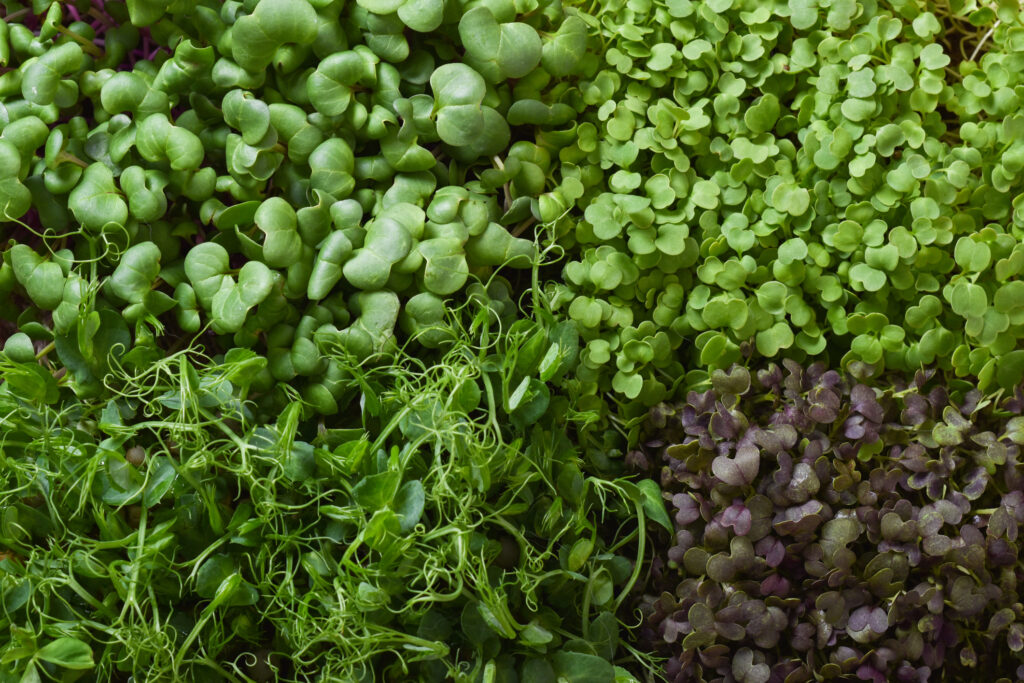
Remember that microgreens have short growth cycles (typically 1-3 weeks), so providing them with the right amount of light is essential to ensure healthy and vigorous growth.
Choosing the right types of Microgreens for Low Light Conditions
When growing microgreens without artificial lights, it’s essential to select varieties that can thrive in partial shade or lower light conditions. Fortunately, there are several microgreen varieties that are well-suited for indoor cultivation without the need for intense sunlight. Here are some excellent choices:
Radish (Raphanus sativus):
Radish microgreens add a delightful peppery flavor and a splash of vibrant color to your dishes. These microgreens are a great source of vitamin C, potassium, and antioxidants. Radish microgreens are well-adapted to low light conditions, and their rapid growth rate allows you to enjoy a harvest in just a week or so.
- Low Light Benefits: Growing radish microgreens in low light ensures they develop tender and milder leaves, as excessive light can sometimes result in spicier greens. Their adaptability to indoor conditions makes them a convenient choice for home gardeners seeking a quick and hassle-free harvest.
Sunflower (Helianthus annuus):
Sunflower microgreens possess a mild, nutty flavor with a satisfying crunch. These tiny greens are rich in essential nutrients like vitamin E, zinc, and selenium. Sunflower microgreens are remarkably resilient and can tolerate partial shade, making them a popular choice for indoor cultivation.
- Low Light Benefits: When grown in low light, sunflower microgreens tend to have a more tender texture and a sweeter taste. With their attractive appearance and excellent nutritional value, they are a delightful addition to salads and sandwiches.

Peas (Pisum sativum):
Pea microgreens offer a delicate, sweet flavor reminiscent of fresh peas. An excellent source of vitamins A, C, and folate, as well as dietary fiber. Pea microgreens are relatively shade-tolerant, making them an ideal option for growing indoors without bright sunlight.
- Low Light Benefits: Growing pea microgreens in low light conditions encourages their tender shoots to develop without becoming overly fibrous. Peas shoots are tender greens that are wonderfully tasteful and also provide a nutritious boost to your meals.
Beetroot (Beta vulgaris):
Beetroot microgreens showcase striking reddish-purple stems and vibrant green leaves, adding a touch of color and earthy flavor to your dishes. These microgreens are a nutritional powerhouse, packed with essential vitamins, minerals, and antioxidants. Beetroot microgreens are well-suited for growing in partial shade, making them an excellent choice for indoor cultivation without artificial lights.
- Low Light Benefits: Cultivating beetroot microgreens in low light conditions encourages their leaves to develop a milder flavor, reducing their earthy undertones. Young, tender leaves are not only visually appealing but also a fantastic source of vitamins and minerals to enhance your daily meals.
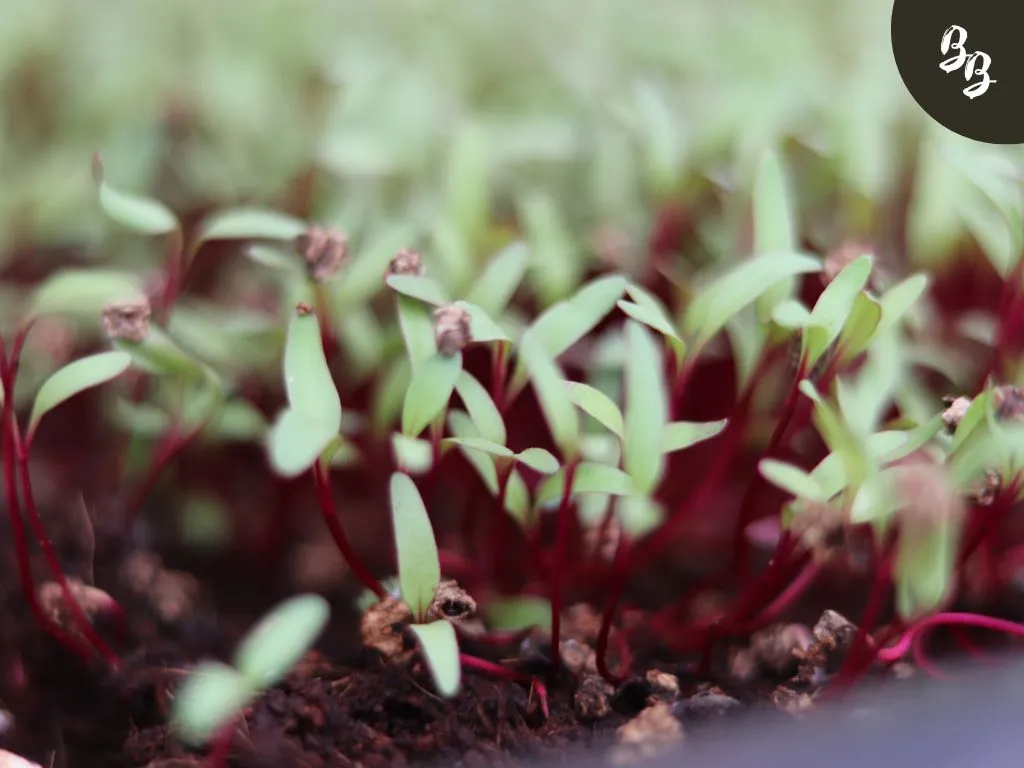
Understanding how much light microgreens need: The benefits of Selecting Low Light Microgreens for Indoor Cultivation:
Space-Efficient:
Growing microgreens in low light allows you to cultivate them indoors without the need for elaborate lighting setups, making it space-efficient and suitable for smaller living spaces.
Energy-Saving:
Since low light microgreens don’t require intense artificial lighting, you save on electricity consumption, making it an eco-friendly and cost-effective option.
Year-Round Cultivation:
With the right selection of low light microgreens, you can enjoy a continuous supply of fresh greens year-round, regardless of seasonal changes and weather conditions.
Cultivating microgreens in low light conditions can be a rewarding and accessible experience for every home gardener. Radish, sunflower, and pea microgreens, along with the previously mentioned varieties, offer a diverse range of flavors and nutrients without the need for elaborate lighting setups. Embrace the versatility of these low light microgreens, and enjoy a continuous supply of fresh, nutritious greens right at your fingertips, no matter the season or location.
The truth about how much light microgreens need: Our high tunnel microgreen growing environment
Creating a high tunnel (hot house) that was used for our microgreens, was one of the best decisions we made. As we started to expanding our microgreen business in 2018, the idea of a water bath system emerged.
Our world of microgreens started to expand and our production had to increase, we built a water bath system in which our trays were kept and watered daily. This was a great option, as we installed the system in our greenhouse which offered natural sunlight.
The water bath system benefits
This system enabled us to achieve “supplemental lighting” in the form of natural sunlight and help us cut down on energy costs. No more buying florescent bulbs, right grow lights or light-emitting diodes.
With the vertical, water bath system we could produce microgreens on a larger scale.
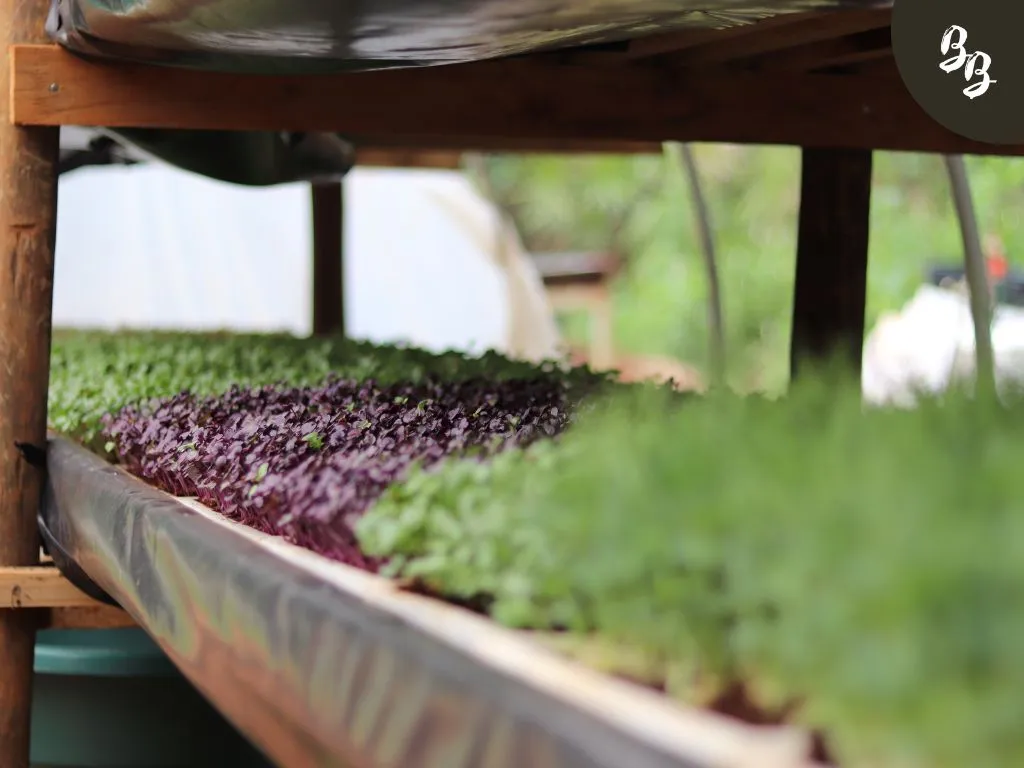
We created the water baths by adding a custom-built wooden rack into the greenhouse frame. An HDPE plastic sheet was added, that formed the base of our bath.
How we built it:
There where two levels in the system; top and bottom. Adding drainage holes on the one side of each bath.
Watering our microgreens, we would fill the top bath up and leave the water inside the bath for +/- 15min. This allowed each tray within the bath to suck up the necessary water they required.
After the 15min, we would open the drainage holes and let the water seep through to the lower-level bath. Opening the last drainage hole every 15-minutes or so, to allow the remaining water to flow into a large container, which was then ready for our veggie garden.
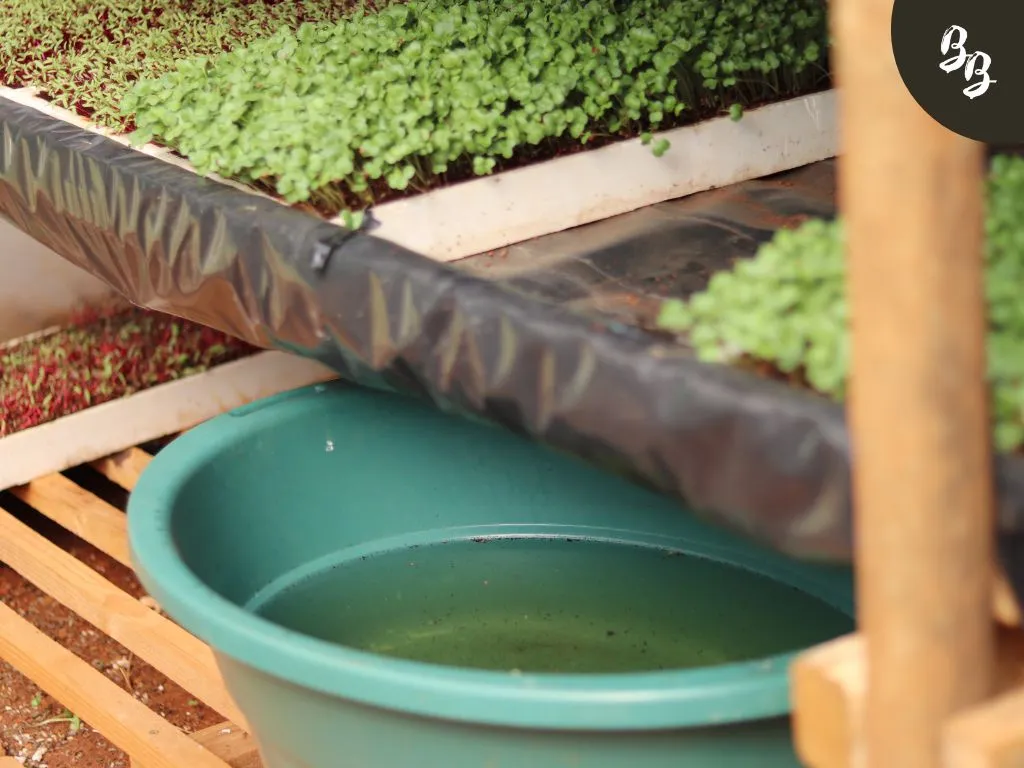
This helped with water conservation. As most of all, we utilized the natural sunlight to grow our microgreens with great success.
In conclusion, while microgreens can grow in natural light, providing additional artificial lighting can offer more control and consistency, ensuring your microgreens thrive regardless of the external environment. So, whether you choose to rely on natural light or incorporate artificial lighting, with proper care and attention, you can enjoy a continuous supply of fresh and nutritious microgreens right at home.

